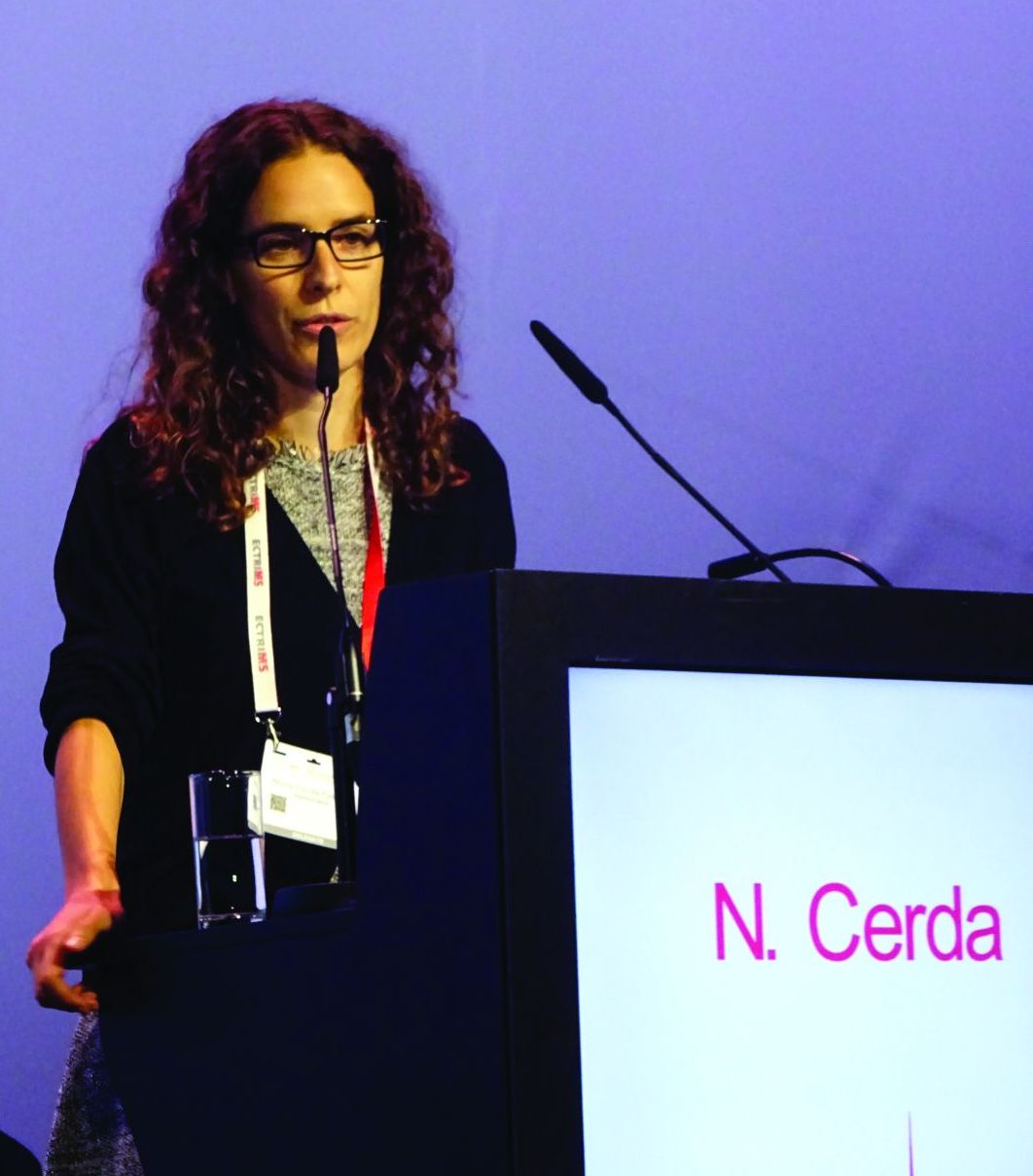User login
BERLIN – At least one-third of patients being treated with fingolimod (Gilenya) for multiple sclerosis (MS) will relapse after stopping the drug, according to data from two “real-world” studies reported at the annual congress of the European Committee for Treatment and Research in Multiple Sclerosis, one of which was undertaken in pregnant women.
In a retrospective analysis of 110 MS patients who discontinued fingolimod from a 433-patient cohort, around 35% experienced a recurrence of disease activity after fingolimod withdrawal. Study investigator Nuria Cerda, MD, of the Neurologic Clinic and Polyclinic at University Hospital Basel (Switzerland), reported that risk factors for increased disease activity were younger rather than older age at MS diagnosis (P = .01) and at discontinuation (P less than .0001), having had a shorter rather than longer disease duration (P = .01), and evidence of MRI-confirmed disease activity occurring while on treatment with fingolimod (P = .02).
“We aimed to describe the frequency of recurrence of disease activity after fingolimod discontinuation in a real-world cohort of MS patients,” Dr. Cerda said. She noted that there were conflicting data on reappearing disease activity after stopping the drug. Case reports and observational data suggest a frequency of 10%-53%, but post hoc analyses of phase 3 trials with fingolimod have not found any higher risk for recurrence versus placebo.
The study also compared “demographic and clinical characteristics in patients with and without recurrence of disease activity, in order to identify possible risk factors for reactivation of the disease.”
The patients included in the study had been treated with fingolimod for a median of 24 months (interquartile range, 10-43 months) and experienced 118 discontinuation events between them. The majority (n = 81) had relapsing-remitting MS, and the remainder (n = 19) were in transition from RRMS to secondary progressive MS.
The mean age at discontinuation was 40 years and, while 60% of patients switched to another disease-modifying therapy (DMT), 40% did not receive further DMT. The reasons for discontinuation were classified as being from disease activity in 44%, side effects in 21%, pregnancy or childbearing preferences in 16%, noncompliance in 2%, and other reasons in 17%.
Recurrence of disease activity was defined as clinical symptoms, gadolinium-enhancing (Gd+) lesions on MRI, or both, within 6 months of stopping fingolimod. This was seen in 38 patients with 41 events, giving a rate of recurrence of 35%. Of these: “almost 60% had clinical and MRI activity, almost 30% had clinical activity only without Gd+ lesions on MRI, and 12% had MRI activity only without ever having a relapse,” Dr. Cerda said. In those who relapsed, the recurrence took a median 8 weeks to happen after fingolimod discontinuation.
A further definition of severe recurrence of disease activity also was used, defined as either a worsening in the Expanded Disability Status Scale (EDSS) score of more than 2 points (signifying a severe relapse) with or without pronounced MRI activity with at least five cerebral Gd+ lesions within 6 months of fingolimod withdrawal. Thirteen severe events were seen in 11 patients, giving a frequency of approximately 11%. Dr. Cerda reported that patients with severe recurrence were significantly younger at MS diagnosis than were those who did not experience recurrence (P = .003). A trend toward a higher annualized relapse rate (ARR) was seen in patients with severely active versus inactive disease (0.84 vs. 0.54), but this was not statistically significant. In addition, “confirmed disability worsening of 1 EDSS point or more was observed in about 3%.”
Relapse rates coming off fingolimod before or during pregnancy
In another study, which used German registry data on 129 pregnancies that occurred around or after the time of fingolimod withdrawal, up to 56% of women who stopped fingolimod before pregnancy experienced a relapse during pregnancy versus 29% of those who stopped fingolimod upon a positive pregnancy test.
In a comparison of women who stopped fingolimod 1 year to 61 days before their last menstrual period against those who stopped less than 60 days prior to or after their last menstrual period, relapse rates were higher during the first (25.8% for early withdrawal vs. 12.5% with late withdrawal) and second trimesters (32.3% vs. 11.5%) than in the third (9.7% vs. 10.4%), Spalmai Hemat, MD, of the department of neurology at St. Josef Hospital, Ruhr University of Bochum (Germany) reported at the congress.
Relapse rates at 6 months postpartum proved to be similar at 36.7% for women who stopped fingolimod before their pregnancy and 38% in those who stopped later. Difference in the percentage of women experiencing disability progression during pregnancy did not prove to be statistically significant for stopping fingolimod before pregnancy (22.7%) vs. stopping later (11.1%; P = .283), while the 23.8% rate of disability progression after pregnancy among women who stopped the drug later versus 13.6% seen with stopping before was also not statistically significant (P = .31). Relapse during pregnancy was the only significant predictor for relapses postpartum.
“The large majority of women did not experience permanent disability,” Dr. Hemat said, but noted that as many as 10%-20% could experience substantial EDSS worsening (2 or more points) at 6 months postpartum.
Dr. Hemat concluded that more data were needed to see if reintroduction of fingolimod very soon after birth, such as within the first 2 weeks, could reduce the postpartum relapse risk.
Dr. Hemat and Dr. Cerda had no relevant disclosures.
SOURCES: Cerda N et al. Mult Scler. 2018;24(S2):73-4, Abstract 206; Hemat S et al. Mult Scler. 2018;24(S2):74-5, Abstract 207.
BERLIN – At least one-third of patients being treated with fingolimod (Gilenya) for multiple sclerosis (MS) will relapse after stopping the drug, according to data from two “real-world” studies reported at the annual congress of the European Committee for Treatment and Research in Multiple Sclerosis, one of which was undertaken in pregnant women.
In a retrospective analysis of 110 MS patients who discontinued fingolimod from a 433-patient cohort, around 35% experienced a recurrence of disease activity after fingolimod withdrawal. Study investigator Nuria Cerda, MD, of the Neurologic Clinic and Polyclinic at University Hospital Basel (Switzerland), reported that risk factors for increased disease activity were younger rather than older age at MS diagnosis (P = .01) and at discontinuation (P less than .0001), having had a shorter rather than longer disease duration (P = .01), and evidence of MRI-confirmed disease activity occurring while on treatment with fingolimod (P = .02).
“We aimed to describe the frequency of recurrence of disease activity after fingolimod discontinuation in a real-world cohort of MS patients,” Dr. Cerda said. She noted that there were conflicting data on reappearing disease activity after stopping the drug. Case reports and observational data suggest a frequency of 10%-53%, but post hoc analyses of phase 3 trials with fingolimod have not found any higher risk for recurrence versus placebo.
The study also compared “demographic and clinical characteristics in patients with and without recurrence of disease activity, in order to identify possible risk factors for reactivation of the disease.”
The patients included in the study had been treated with fingolimod for a median of 24 months (interquartile range, 10-43 months) and experienced 118 discontinuation events between them. The majority (n = 81) had relapsing-remitting MS, and the remainder (n = 19) were in transition from RRMS to secondary progressive MS.
The mean age at discontinuation was 40 years and, while 60% of patients switched to another disease-modifying therapy (DMT), 40% did not receive further DMT. The reasons for discontinuation were classified as being from disease activity in 44%, side effects in 21%, pregnancy or childbearing preferences in 16%, noncompliance in 2%, and other reasons in 17%.
Recurrence of disease activity was defined as clinical symptoms, gadolinium-enhancing (Gd+) lesions on MRI, or both, within 6 months of stopping fingolimod. This was seen in 38 patients with 41 events, giving a rate of recurrence of 35%. Of these: “almost 60% had clinical and MRI activity, almost 30% had clinical activity only without Gd+ lesions on MRI, and 12% had MRI activity only without ever having a relapse,” Dr. Cerda said. In those who relapsed, the recurrence took a median 8 weeks to happen after fingolimod discontinuation.
A further definition of severe recurrence of disease activity also was used, defined as either a worsening in the Expanded Disability Status Scale (EDSS) score of more than 2 points (signifying a severe relapse) with or without pronounced MRI activity with at least five cerebral Gd+ lesions within 6 months of fingolimod withdrawal. Thirteen severe events were seen in 11 patients, giving a frequency of approximately 11%. Dr. Cerda reported that patients with severe recurrence were significantly younger at MS diagnosis than were those who did not experience recurrence (P = .003). A trend toward a higher annualized relapse rate (ARR) was seen in patients with severely active versus inactive disease (0.84 vs. 0.54), but this was not statistically significant. In addition, “confirmed disability worsening of 1 EDSS point or more was observed in about 3%.”
Relapse rates coming off fingolimod before or during pregnancy
In another study, which used German registry data on 129 pregnancies that occurred around or after the time of fingolimod withdrawal, up to 56% of women who stopped fingolimod before pregnancy experienced a relapse during pregnancy versus 29% of those who stopped fingolimod upon a positive pregnancy test.
In a comparison of women who stopped fingolimod 1 year to 61 days before their last menstrual period against those who stopped less than 60 days prior to or after their last menstrual period, relapse rates were higher during the first (25.8% for early withdrawal vs. 12.5% with late withdrawal) and second trimesters (32.3% vs. 11.5%) than in the third (9.7% vs. 10.4%), Spalmai Hemat, MD, of the department of neurology at St. Josef Hospital, Ruhr University of Bochum (Germany) reported at the congress.
Relapse rates at 6 months postpartum proved to be similar at 36.7% for women who stopped fingolimod before their pregnancy and 38% in those who stopped later. Difference in the percentage of women experiencing disability progression during pregnancy did not prove to be statistically significant for stopping fingolimod before pregnancy (22.7%) vs. stopping later (11.1%; P = .283), while the 23.8% rate of disability progression after pregnancy among women who stopped the drug later versus 13.6% seen with stopping before was also not statistically significant (P = .31). Relapse during pregnancy was the only significant predictor for relapses postpartum.
“The large majority of women did not experience permanent disability,” Dr. Hemat said, but noted that as many as 10%-20% could experience substantial EDSS worsening (2 or more points) at 6 months postpartum.
Dr. Hemat concluded that more data were needed to see if reintroduction of fingolimod very soon after birth, such as within the first 2 weeks, could reduce the postpartum relapse risk.
Dr. Hemat and Dr. Cerda had no relevant disclosures.
SOURCES: Cerda N et al. Mult Scler. 2018;24(S2):73-4, Abstract 206; Hemat S et al. Mult Scler. 2018;24(S2):74-5, Abstract 207.
BERLIN – At least one-third of patients being treated with fingolimod (Gilenya) for multiple sclerosis (MS) will relapse after stopping the drug, according to data from two “real-world” studies reported at the annual congress of the European Committee for Treatment and Research in Multiple Sclerosis, one of which was undertaken in pregnant women.
In a retrospective analysis of 110 MS patients who discontinued fingolimod from a 433-patient cohort, around 35% experienced a recurrence of disease activity after fingolimod withdrawal. Study investigator Nuria Cerda, MD, of the Neurologic Clinic and Polyclinic at University Hospital Basel (Switzerland), reported that risk factors for increased disease activity were younger rather than older age at MS diagnosis (P = .01) and at discontinuation (P less than .0001), having had a shorter rather than longer disease duration (P = .01), and evidence of MRI-confirmed disease activity occurring while on treatment with fingolimod (P = .02).
“We aimed to describe the frequency of recurrence of disease activity after fingolimod discontinuation in a real-world cohort of MS patients,” Dr. Cerda said. She noted that there were conflicting data on reappearing disease activity after stopping the drug. Case reports and observational data suggest a frequency of 10%-53%, but post hoc analyses of phase 3 trials with fingolimod have not found any higher risk for recurrence versus placebo.
The study also compared “demographic and clinical characteristics in patients with and without recurrence of disease activity, in order to identify possible risk factors for reactivation of the disease.”
The patients included in the study had been treated with fingolimod for a median of 24 months (interquartile range, 10-43 months) and experienced 118 discontinuation events between them. The majority (n = 81) had relapsing-remitting MS, and the remainder (n = 19) were in transition from RRMS to secondary progressive MS.
The mean age at discontinuation was 40 years and, while 60% of patients switched to another disease-modifying therapy (DMT), 40% did not receive further DMT. The reasons for discontinuation were classified as being from disease activity in 44%, side effects in 21%, pregnancy or childbearing preferences in 16%, noncompliance in 2%, and other reasons in 17%.
Recurrence of disease activity was defined as clinical symptoms, gadolinium-enhancing (Gd+) lesions on MRI, or both, within 6 months of stopping fingolimod. This was seen in 38 patients with 41 events, giving a rate of recurrence of 35%. Of these: “almost 60% had clinical and MRI activity, almost 30% had clinical activity only without Gd+ lesions on MRI, and 12% had MRI activity only without ever having a relapse,” Dr. Cerda said. In those who relapsed, the recurrence took a median 8 weeks to happen after fingolimod discontinuation.
A further definition of severe recurrence of disease activity also was used, defined as either a worsening in the Expanded Disability Status Scale (EDSS) score of more than 2 points (signifying a severe relapse) with or without pronounced MRI activity with at least five cerebral Gd+ lesions within 6 months of fingolimod withdrawal. Thirteen severe events were seen in 11 patients, giving a frequency of approximately 11%. Dr. Cerda reported that patients with severe recurrence were significantly younger at MS diagnosis than were those who did not experience recurrence (P = .003). A trend toward a higher annualized relapse rate (ARR) was seen in patients with severely active versus inactive disease (0.84 vs. 0.54), but this was not statistically significant. In addition, “confirmed disability worsening of 1 EDSS point or more was observed in about 3%.”
Relapse rates coming off fingolimod before or during pregnancy
In another study, which used German registry data on 129 pregnancies that occurred around or after the time of fingolimod withdrawal, up to 56% of women who stopped fingolimod before pregnancy experienced a relapse during pregnancy versus 29% of those who stopped fingolimod upon a positive pregnancy test.
In a comparison of women who stopped fingolimod 1 year to 61 days before their last menstrual period against those who stopped less than 60 days prior to or after their last menstrual period, relapse rates were higher during the first (25.8% for early withdrawal vs. 12.5% with late withdrawal) and second trimesters (32.3% vs. 11.5%) than in the third (9.7% vs. 10.4%), Spalmai Hemat, MD, of the department of neurology at St. Josef Hospital, Ruhr University of Bochum (Germany) reported at the congress.
Relapse rates at 6 months postpartum proved to be similar at 36.7% for women who stopped fingolimod before their pregnancy and 38% in those who stopped later. Difference in the percentage of women experiencing disability progression during pregnancy did not prove to be statistically significant for stopping fingolimod before pregnancy (22.7%) vs. stopping later (11.1%; P = .283), while the 23.8% rate of disability progression after pregnancy among women who stopped the drug later versus 13.6% seen with stopping before was also not statistically significant (P = .31). Relapse during pregnancy was the only significant predictor for relapses postpartum.
“The large majority of women did not experience permanent disability,” Dr. Hemat said, but noted that as many as 10%-20% could experience substantial EDSS worsening (2 or more points) at 6 months postpartum.
Dr. Hemat concluded that more data were needed to see if reintroduction of fingolimod very soon after birth, such as within the first 2 weeks, could reduce the postpartum relapse risk.
Dr. Hemat and Dr. Cerda had no relevant disclosures.
SOURCES: Cerda N et al. Mult Scler. 2018;24(S2):73-4, Abstract 206; Hemat S et al. Mult Scler. 2018;24(S2):74-5, Abstract 207.
REPORTING FROM ECTRIMS 2018
Key clinical point:
Major finding: A higher risk of recurrent disease activity was seen in younger MS patients with shorter disease duration and evidence of disease activity while on fingolimod treatment. Pregnant women who stopped more than 2 months before a planned pregnancy also had a higher risk versus those who stopped after a positive pregnancy test.
Study details: A retrospective analysis of 110 MS patients who discontinued fingolimod from a 433-patient cohort, and German registry data on 129 pregnancies that occurred around or after the time of fingolimod withdrawal.
Disclosures: Dr. Spalmai Hemat and Dr. Nuria Cerda had no relevant disclosures.
Sources: Cerda N et al. Mult Scler. 2018;24(S2):73-4, Abstract 206; Hemat S et al. Mult Scler. 2018;24(S2):74-5, Abstract 207.


